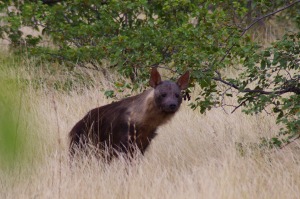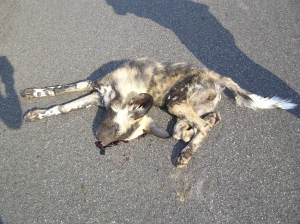Wildlife Road Traffic Accidents – A Biodiversity Research Project
MOTIVATION
“As a killer of men, the automobile is more deadly than typhoid fever and runs a close second to influenza … not only is the mortality among human beings high, but the death-dealing qualities of the motor car are making serious inroads on our native mammals, birds and other forms of animal life.” (Stoner, 1924)
INTRODUCTION
Wildlife roadkill signal a threat to biodiversity that can have long-term effects on ecosystems (IUCN Red List, 2008). One million animals are killed each year on highways in the United States—these statistics do not account for animals that crawl off the road to die after being hit, and nor do they account for all species (Noss, 2002).
There is, at present, no standardised method for data collection of animals killed on South African roads and so we cannot quantify the threat of roadkill accidents to South Africa’s wildlife.
This project will conduct a critical assessment of Wildlife Road Traffic Accidents (WRTAs) in the Greater Mapungubwe Transfrontier Conservation Area (GMTFCA), monitoring measures to develop an effective standardised toolkit that can be employed to better understand the factors contributing to WRTAs and consequently to assess threats to biodiversity from WRTAs across the country.
PROJECT OBJECTIVES
1. To develop a cost-effective and accurate method of monitoring WRTAs, resulting in a standardised tool-kit/protocol for collecting data on roadkill in South Africa.
2. To obtain baseline rates for WRTAs for all species, in one important conservation area in South Africa, namely the Greater Mapungubwe Transfrontier Conservation Area (GMTFCA).
3. To assess the influence of animal behaviour, habitat type and land use, season, population densities, road physical characteristics and traffic volume on roadkill.
4. To develop recommendations for mitigation that can reduce the impact of road infrastructure on biodiversity, as well as contribute towards possible norms and standards for future road design and improvement.
5. To make recommendations to raise public awareness of WRTAs, and systematic monitoring, through developing “National WRTA Awareness Days”.
METHODS
Road transects will be driven at standardised intervals in both summer and winter months. Both dirt and tar roads in the Greater Mapungubwe Transfrontier Conservation Area (GMTFCA) will be driven (see map). All WRTAs will be recorded, with identification to species level whenever possible.
Figure 1: Map of South Africa
Figure 2: The study area – Greater Mapungubwe Transfrontier Conservation Area (GMTFCA)
This data will be used to develop a toolkit that will then be tested to obtain baseline WRTA rates in the GMTFCA.








Dear Wendy,
Could you explain me the graph more in detail? Like what is the number (n) of animals found. Why did you seperate birds of prey, and what is the other 1%?
Regards,
Rob de Boer
Masterstudent Biology – Wageningen University – The Netherlands
David Collinson
09:19 AM Aug 12
As a fairly regular visitor to SA it dismays me to see the native fauna enclosed into smaller and smaller spaces and placed at risk with the increasing traffic in isolated places Reply
#2Peter Neville
01:12 PM Oct 10
Effective conservation is a multi-level task and we can all play a part to ensure the future of our wildlife. Driving slower and more carefully especially at dawn, dusk and at night can save animal lives all over the world and nowhere more so perhaps than in the amazing wildlife diversity of South Africa. Supporting initiatives there and research such as Wendy Collinson’s study is another way that we can all help..please support her project…give generously…it’ll make you feel good and help her help the authorities devise better ways of protecting wildlife. Reply
#3Charlie Ellis
02:59 PM Oct 10
The country is in desperate need of your project- especially with all of the plans for transfrontier parks that will hopefully see the dropping of many fences. Without this work, such initiatives could see for disasterous consequences on the roads next to where these fences use to lie. Reply
#4Susan Miller
06:41 AM Oct 11
Wendy, your project is so important, especially with the proposed coal mines near Mapungubwe that would see increased traffic in the area resulting in an even great impact on the local wildlife. Reply
#5susan sims
12:08 PM Oct 11
Wendy, the work you are doing is so very important as it is something very few of us even stop to think about. Thank you for opening our eyes, keep up your tremendous effort in helping to bring your research to the forefront of us all. Reply
#6Neil Aldridge
05:45 PM Oct 11
As the concept of landscape-scale conservation moves towards linking-up wildlife populations, so more and more roads linking human populations will come into play. This is not just a study of a road network in a far corner of South Africa’s Limpopo Province, it is a study that could influence conservation and development planning across a rapidly developing continent of more than a billion people. And in a locality with one existing mine, one proposed mine, one world heritage site, a road linking two international border posts, a national park and many other nature reserves, there couldn’t be a more timely and fitting research project. Good luck Wendy, let’s make this happen! Reply
#7Endangered Wildlife Trust11:42 AM Oct 25
Thank you for all your comments. Please see the YouTube video now added to this page. Please continue to support and encourage Wendy’s work – The more people behind her project, the more successful results it will yield!
Hi Rob,
Thanks for the question. The number of species found over the 3-month pilot study period was 171, from which I split into catergories. I split ‘birds’ and ‘birds of prey’ for no other reason than that I found this quite interesting and possibly worthy of follow up when I conduct the full study. Many of the birds of prey, I suspect, are secondary roadkill victims, as in, they are scavenging on the road and are accidentally hit.
With regards the ‘other’ 1% … thanks for bringing this to my attention – it got left off the legend when I transfered the graph over. The 1% refers to ‘unknown’ roadkill, that is, it was either too decomposed or flattened to be identified.
I am astonished at the amount of wildlife being killed on these roads. Even from this early data, it seems that the motor car is clearly one of the, if not the major ‘predator’ for some of these species. Your studies may reveal that this is especially so at certain times of year at least when populations migrate or young adults disperse away from their rearing environment. I suspect that you will uncover some shocking truths. In my idealistic mind, maybe that will lead to some kind of pioneering change to the way that that roads all over the world are designed with respect to, and respect for wildlife. Keep your findings and thoughts public!!